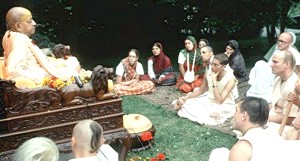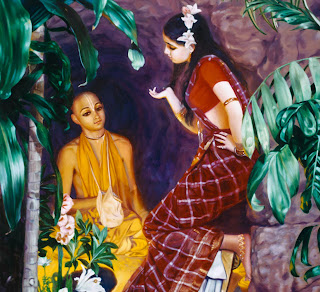(Kadamba Kanana Swami, 24 April 2014, Radhadesh, Belgium, Caitanya Caritamrta Lecture)
At every moment, we are drowning in mercy – this is an amazing Movement! Our relationship is centered solely around Krsna and is meant to deal with the Absolute Truth, as it is presented in the scripture and in accordance with kala, desha, patra – time, place and circumstance, which actually means the reality of our situation.
 This is what we are looking at – presenting Krsna consciousness according to the reality of our situation. That is my topic, my angle where we say, ‘I have to crystallize this Krsna consciousness to the point where it deals with the reality of where we are at.’ You can see that is actually what Prabhupada did. He dealt with the hippies from Lower East Side and brought Krsna consciousness down to them.
This is what we are looking at – presenting Krsna consciousness according to the reality of our situation. That is my topic, my angle where we say, ‘I have to crystallize this Krsna consciousness to the point where it deals with the reality of where we are at.’ You can see that is actually what Prabhupada did. He dealt with the hippies from Lower East Side and brought Krsna consciousness down to them.
So certain things could be done and certain things could not be done. About ekadasi and deity worship; these things he kept simple and he did not get too much carried away in ritual. One could say that people were not qualified and therefore not able to deal with it – maybe, but that might have not been the sole reason. Another reason to keep the rituals simple might have been because it is, in a way, secondary to the substance of chanting Hare Krsna and of sankirtan.
Now, we are learning more and more and sometimes, a bit more ritual has come than what was existing in the 70’s. Alright, it can be there because this is the time when we have everything: we have the Vedic approach, we have the Krsna West approach, we have so many approaches, grihasta approach, brahmacari approach, we have academic approach… So as a Movement, we start to get many different approaches to Krsna consciousness. It is no longer just simply, ‘Do you wanna be a devotee?
‘Aww, well I think yes.’
‘Ok, why don’t you join the temple?’
‘Well, yes, I mean, I guess, I will join the temple.’ That was the 70’s. You want to be a devotee, then – join the temple! So it was either you want to be a devotee and join the temple or you are not a devotee; that is how it was. Now it is of course different, now it is more of what kind of devotee are you going to be?
A temple devotee, a congregational devotee, an academic devotee, a professional, or a type doing little business on a side and live close to the temple…? So many different ways of life and what to be? But then, there is somebody like me, who is of no help to such decisions in life, ‘Is it good if I move in a temple?’
 ‘Yes.’
‘Yes.’
‘Is it good if get a job outside and just chant sixteen rounds and follow the principles?’
‘Yes.’ It is all good.
‘Is it good if I get married?’
‘Yes.’
‘Is it good if I stay brahmacari?’
‘Yes.’ It is all good. See, I don’t give you any answers. All I do is hold options in front of your nose, ‘Well, you could do this or you could do that but you decide.’
‘But for God’s sake, tell me what to do!!!’
But I am not going to. I refuse; I don’t want to. The reason is that I don’t want dependent people; I want people who can make decisions and live by their decisions.
‘But please tell me what the right decision is?’
The answer is that on the material plane, anything dealing with material energy – there is no right decision, as every decision brings pleasure and pain! That is material life.
‘What ashram should I chose?!’
I don’t know… which one you like the best? Of course, for some people I have a plan and I would tell them what ashram I would like them to be in, that may also be true. But for majority of people, I say choose whatever you like but make it Krsna conscious. You see, the ashram is not the magic fix, making it Krsna conscious is what it is all about. Grhasta ashram is great if you make it Krsna conscious, brahmachari ashram is really good if you make it Krsna conscious, vanaprasta ashram is good if you can find a way to do it, sannyasa – yes, it is the great blessing but one has to really do something to make it happen.






 With Sivarama Swami.
With Sivarama Swami. 
 Glimpses of Ratha Yatra 2014 Heidelberg, Germany!
Glimpses of Ratha Yatra 2014 Heidelberg, Germany! 

 Mukhya devi dasi: Congratulations to the students of the Bhaktivedanta Academy on the completion of their school year. I attended their closing ceremonies last Friday and was overwhelmed by the love and dedication of the teaching staff, the joy of the children and seeing just how much Krishna consciousness they were all learning. The middle school students have learned every verse of the Sri Gurv-astaka prayers in Sanskrit and English and each student chanted perfectly one verse for the ceremonies. Even among mundane education systems it is so rare to get the kind of personal input that our teachers at BANA give their students, what to speak of combining that kind of care with Vedic knowledge and understanding. All glories to the parents who sacrifice their time helping this school thrive and their income sending their children for this very specialized spiritual education. It is all paying off producing a generation of devotees who are powerful and intelligent in ways we have not yet seen.
Mukhya devi dasi: Congratulations to the students of the Bhaktivedanta Academy on the completion of their school year. I attended their closing ceremonies last Friday and was overwhelmed by the love and dedication of the teaching staff, the joy of the children and seeing just how much Krishna consciousness they were all learning. The middle school students have learned every verse of the Sri Gurv-astaka prayers in Sanskrit and English and each student chanted perfectly one verse for the ceremonies. Even among mundane education systems it is so rare to get the kind of personal input that our teachers at BANA give their students, what to speak of combining that kind of care with Vedic knowledge and understanding. All glories to the parents who sacrifice their time helping this school thrive and their income sending their children for this very specialized spiritual education. It is all paying off producing a generation of devotees who are powerful and intelligent in ways we have not yet seen.  900 hundred people got prasadam, on each of these days.
One young man Kerim, member of "Crisis stuff Nemila", helped devotees in all the places, he even distributed prasadam by himself. Therefore, devotees invited him to our Sunday feast and he came. He associated with devotees, heard Madhukanta prabhu's lecture about glories of Krsna prasadam, received Srila Prabhupada's book and box of maha prasadam, he danced in kirtan and stayed overnight in our temple.
Our Hungarian friends, who served tirelessly for 10 days, went back home on Monday. They even refused our offer to show them Baščaršija (Old Sarajevo) and around the city, explaining that they came only to do service.
Serving together in FFL was very deep and emotional experience for all of us, and we sincerely hope that they will come back soon.
FFL Phase 1 was a marathon for many enthusiastic devotees who took part.
They served tirelessly from 5 am until 10 pm for 15 days!
6000 people got prasadam in total for this phase 1 of our prasadam distribution!
We will take a short break to reorganize and continue very soon! Please keep supporting, donating, offering your services for phase 2.
Stay tuned, FFL Bosnia is coming back soon!
900 hundred people got prasadam, on each of these days.
One young man Kerim, member of "Crisis stuff Nemila", helped devotees in all the places, he even distributed prasadam by himself. Therefore, devotees invited him to our Sunday feast and he came. He associated with devotees, heard Madhukanta prabhu's lecture about glories of Krsna prasadam, received Srila Prabhupada's book and box of maha prasadam, he danced in kirtan and stayed overnight in our temple.
Our Hungarian friends, who served tirelessly for 10 days, went back home on Monday. They even refused our offer to show them Baščaršija (Old Sarajevo) and around the city, explaining that they came only to do service.
Serving together in FFL was very deep and emotional experience for all of us, and we sincerely hope that they will come back soon.
FFL Phase 1 was a marathon for many enthusiastic devotees who took part.
They served tirelessly from 5 am until 10 pm for 15 days!
6000 people got prasadam in total for this phase 1 of our prasadam distribution!
We will take a short break to reorganize and continue very soon! Please keep supporting, donating, offering your services for phase 2.
Stay tuned, FFL Bosnia is coming back soon!  Taken in Poway, California
Taken in Poway, California  Glorification of the Supreme Personality of Godhead is performed in the paramparä system; that is, it is conveyed from spiritual master to disciple. Such glorification is relished by those no longer interested in the false, temporary glorification of this cosmic manifestation. Descriptions of the Lord are the right medicine for the conditioned soul undergoing repeated birth and death. Therefore, who will cease hearing such glorification of the Lord except a butcher or one who is killing his own self? SB 10.1.4
Glorification of the Supreme Personality of Godhead is performed in the paramparä system; that is, it is conveyed from spiritual master to disciple. Such glorification is relished by those no longer interested in the false, temporary glorification of this cosmic manifestation. Descriptions of the Lord are the right medicine for the conditioned soul undergoing repeated birth and death. Therefore, who will cease hearing such glorification of the Lord except a butcher or one who is killing his own self? SB 10.1.4  With Niranjana Swami and Prithu Prabhu. Oh, how glorious are they whose tongues are chanting Your holy name! Even if born in the families of dog-eaters, such persons are worshipable. Persons who chant the holy name of Your Lordship must have executed all kinds of austerities and fire sacrifices and achieved all the good manners of the Äryans. To be chanting the holy name of Your Lordship, they must have bathed at holy places of pilgrimage, studied the Vedas and fulfilled everything required. SB 3.33.7
With Niranjana Swami and Prithu Prabhu. Oh, how glorious are they whose tongues are chanting Your holy name! Even if born in the families of dog-eaters, such persons are worshipable. Persons who chant the holy name of Your Lordship must have executed all kinds of austerities and fire sacrifices and achieved all the good manners of the Äryans. To be chanting the holy name of Your Lordship, they must have bathed at holy places of pilgrimage, studied the Vedas and fulfilled everything required. SB 3.33.7 







